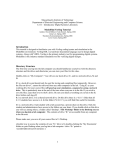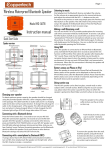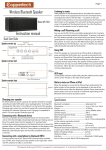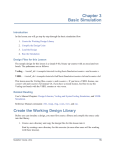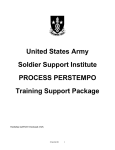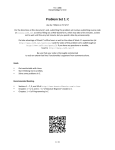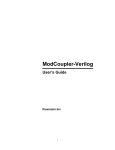Download 1 ModelSim/Verilog Tutorial Introduction Directory Structure
Transcript
Massachusetts Institute of Technology Department of Electrical Engineering and Computer Science 6.111 – Introductory Digital Systems Laboratory ModelSim/Verilog Tutorial Authors: David Milliner, Frank Honoré, Spring, 2004 Jenny Lee, Spring, 2005 * There have been some important changes to this document, which are indicated by underlining. If you have already read this document, please read at least the underlined parts. The newly added/modified sections are What are Library and Project, Creating Files in ModelSim, and Wave Window, and Useful Buttons and Command Lines. Introduction This tutorial is designed to familiarize you with Verilog coding/syntax and simulation in the ModelSim environment. Verilog HDL is a hardware description language used to design digital systems. Along with VHDL, Verilog is the primary industry tool for programming digital systems. ModelSim is the industry standard simulation tool for verifying digital designs. Directory Structure When you log into the lab computers you will have access to your own drive (U:/) and a directory in the local drive (E:/) where you can store your files for this class. For ModelSim to operate correctly, you must store all your source files (*.v) in E:/Documents and Settings/[Athena Username]/Desktop or equivalently on the Desktop of your local machine. This directory is linked directly to U:/Desktop, but please make sure you use source files stored in E:/ directory rather than U:/Desktop when using ModelSim. Although this directory is accessible from any computers in the lab area, you will probably want to back these files up on your Athena account from time to time. You can transfer files back and forth from your Athena account using WinSCP. On the Desktop of your local computer, create a tutorial folder with the subfolders src and sims. The src folder will contain the source codes for this tutorial and the sims directory is where you will be compiling your code. On the lab PCs you will see a shared drive (S:/) from which you should be able to access the files necessary for this tutorial. Copy the files from the S:/6.111/tutorial2/ folder to your src folder on your Desktop. The files to copy are counter.v, top.v, tb_tutorial.v, full_adder.v, full_adder_4bit.v, and test_adder.v. Verilog Source Code and Testbench The file counter.v is a simple two-bit Verilog counter designed to divide the input clock by four. This counter is designed to reset back to zero on the positive assertion of the reset signal. Your counter is instantiated in the top level file top.v. The file tb_tutorial.v is used to simulate the counter module in counter.v. We recommend you spend a few minutes familiarizing yourself with this code and the Verilog syntax. 1 Opening ModelSim You can access ModelSim either through the PCs in the lab or an Athena Sun Workstation. On the Lab PC under Windows XP, launch ModelSim from the Desktop icon (or Start > All Programs > ModelSim SE > ModelSim). If it’s your first time opening ModelSim or if you encounter problems with licenses, you can run the license wizard: Start > All Programs > ModelSim SE > Licensing Wizard. The license file should be set to ‘[email protected]’. On Athena Sun workstation, first run 'setup 6.111' to configure your environment correctly. Then run 'vsim &' to start the application. Online help and tutorials for ModelSim are available from the Help pull-down menu. Help > SE PDF Documentation > Tutorial will bring up the guide for a recommended tutorial. The PDF for the user's manual is also available on the course website: Software Tools > Verilog Simulation. (must have MIT certificates). What are Library and Project? Before jumping into using ModelSim, there are two important components you should get familiar with: Library and Project. Library provides an environment for you to compile and simulate your design, while Project provides you a place to contain all relevant files and settings for independent design including its working library. Library: A directory that contains compiled design units, such as modules. There are two types of libraries: Resource Library and Working Library: Resource Library: contains static contents, such as the compiled version of standard modules. Resource libraries, such as ieee, can be found in the ‘library’ pane on the left-hand side of ModelSim. Working Library: contains the compiled version of your design. The contents of a working library change every time you compile your design. The default working library in ModelSim is named work and is predefined in the ModelSim compiler. The working library when created or linked to your source code can be accessed through the ‘library’ pane on the left-hand side of ModelSim. Project: A collection of various files for designs under test, such as Verilog source files, local working libraries, references to resource libraries, and simulation configuration (*.mpf files). 2 Creating files in ModelSim There are two ways to start creating your designs in ModelSim: 1.Creating a project or 2.Opening or creating a Verilog file without a project. 1. Creating a project Create a new project: File > New > Project Specify your project name and specify the Project Location as a directory under E:\Documents and Settings\[username]\Desktop. Leave the Default Library Name to work. Now, you have created a project .mpf file and a working library, which can store useful information, such as your simulation configuration, for future use. Now, add items to your project by either creating a new Verilog source file or adding an existing file. 2. Creating without a project: Create a new file: File > New > Source > Verilog or open an existing Verilog file: File > Open > File. To compile the source files in the ModelSim environment, you must create a working directory or map an existing working directory: File > New > Library or File > Import > Library or type ‘vlib work’ in the command line window. As a good design practice, we recommend you to follow the first option: creating a new project. For Verilog files required for labs and psets, create a new project such as ‘lab01’ or ‘pset03’ under the default work library as its working library, because you do not explicitly need to specify the work library when compiling. For the final project, which contains many layers of hierarchy, create a new project under a new working library, such as ‘final_proj’. For this tutorial, we are using the second option: opening existing files and creating a new working library called sims. If you are not already located in your sims directory, then move into this directory using the ModelSim command line. On the left-hand side of the ModelSim window, you should see a number of resource libraries (vital2000, ieee, etc...): Right-click in this window and select to create a new library, called ‘sims’, or type ‘vlib sims’ in the command line. Compiling in ModelSim Compile source files: Compile > Compile. You will see that the default library is the work library. Choose to compile your files in the newly created sims library rather than the work library. To compile your files, browse to your src directory and select the files counter.v, top.v and tb_tutorial.v. Double-click the selected files to compile. We will use the other files later in this tutorial. If there is an error in your Verilog code it will be reported at this time with an error message. Your downloaded tutorial files should not contain any errors. 3 You can recompile your files by looking at the ‘library’ pane. On the left-hand side of ModelSim window, choose the ‘library’ tab and click on the square containing plus sign next to sims working library. You should see the three files you compiled earlier under sims library. Highlight the files you want to recompile, and when you right-click on those files, you can delete, recompile or simulate the highlighted files. Simulation You are now ready to simulate the counter module using the testbench tb_tutorial.v in your sims directory. To simulate, you can either use the graphic interface (see Useful Buttons and Command Line section) or use the commands described below: To simulate your testbench: > vsim sims.tb_tutorial To run the testbench: > run 100us To restart your simulation: > restart –f Viewing Simulations – The Wave Window To graphically view your testbench pull down the View menu: View > Debug Windows > Wave. From the left-hand side of the ModelSim window, you should see blue dots representing the modules in your design. This should have occurred when you compiled your testbench. Drag the blue dot representing the modules in your design into the Wave window. In the Wave window, if you do not want to use testbench, you can also specify the behaviors of your input waveforms, just like in Max+ Plus II. Right-click on the input signal, a, b or cin and select Create/Modify Waveform. You can set the input signals to a clock, constant, random, repeater or counter. Once you set the input signals, you can also manually draw the waveform by highlighting the parts of your wave, right-click, and select Edit Wave > Invert or Mirror or Value. Restart your simulation (type restart –f) and run for 100us. You should see the clock signal, reset signal, clock divided by four signal, and two-bit counter value. Zoom out to see the entire Wave window. You can select to have your data represented in a number of different ways although most of you will probably choose to use binary or decimal representation. By default, when you close the Wave window, all the information is forgotten. Thus, if you want to save your waveforms, you must save a Wave window format file (*.do) under your project: File > Save > Format. 4 Useful Buttons and Command Lines Buttons Description* Command Line To compile: Compile this file open the Compile Source File dialog; in a project, compile the file vlog -work [working library] [filename.v] ex) vlog –work work tb_tutorial.v To recompile: vlog –work [working library] –refresh Compile All compile all files in the open project Compile > Compile All Simulate load the selected design unit or simulation configuration object vsim -c [working library].[file name] Restart reload the design elements and reset the simulation time to zero, with the option of using current formatting, breakpoints, WLF file, virtual definitions, and assertion settings restart -f Run run the current simulation for the specified run length run Open Wave Viewer Ex) vsim –c work.tb_tutorial Window > Wave Zoom Mode set mouse to Zoom Mode – drag left mouse button to zoom, click middle mouse button to select N/A Insert Cursor add a cursor to the waveform pane Insert > Cursor *The button descriptions are copied from User’s Manual v5.8b (se_man.pdf) published by ModelSim®. 5 Exercise You should now feel comfortable in the ModelSim environment. As an exercise to demonstrate your familiarity with the environment compile and run the full-adder testbench found at (S:/6.111/tutorial2). The viewgraph from lecture describing this exercise is shown below. You can also try creating your own modules and verifying their functionality. Acknowledgements: This tutorial and counter code is written by David Milliner and adder module and testbench is written by Frank Honoré. Some sections are added and modified by Jenny Lee. 6






